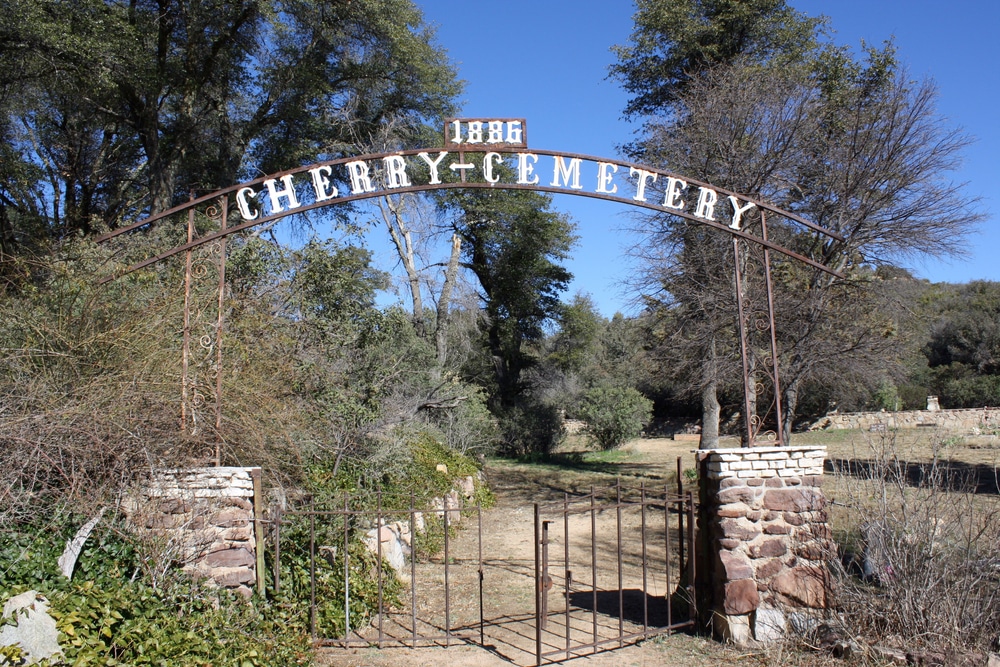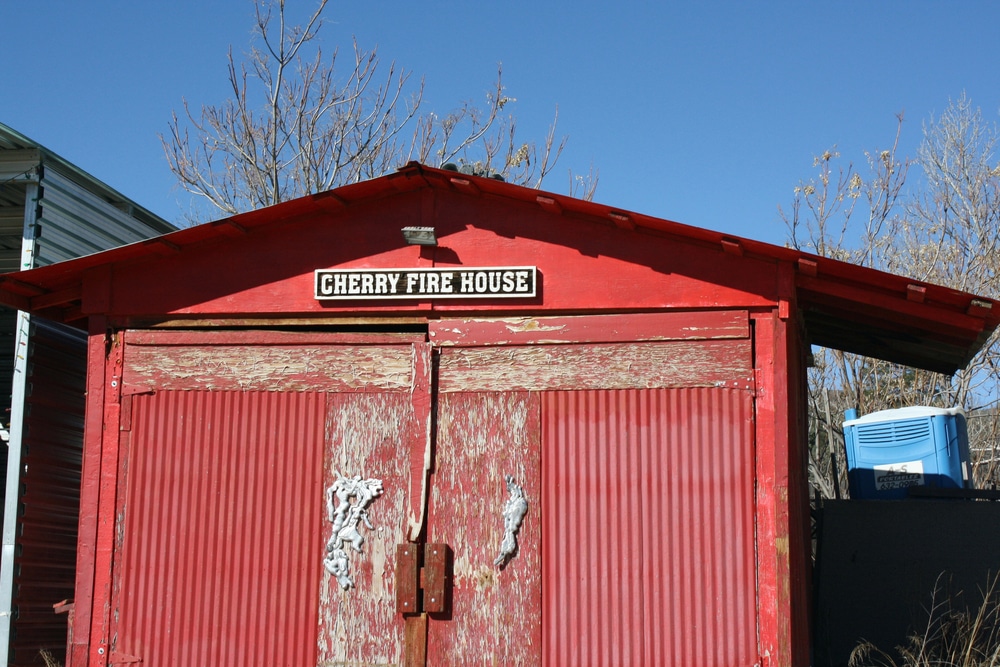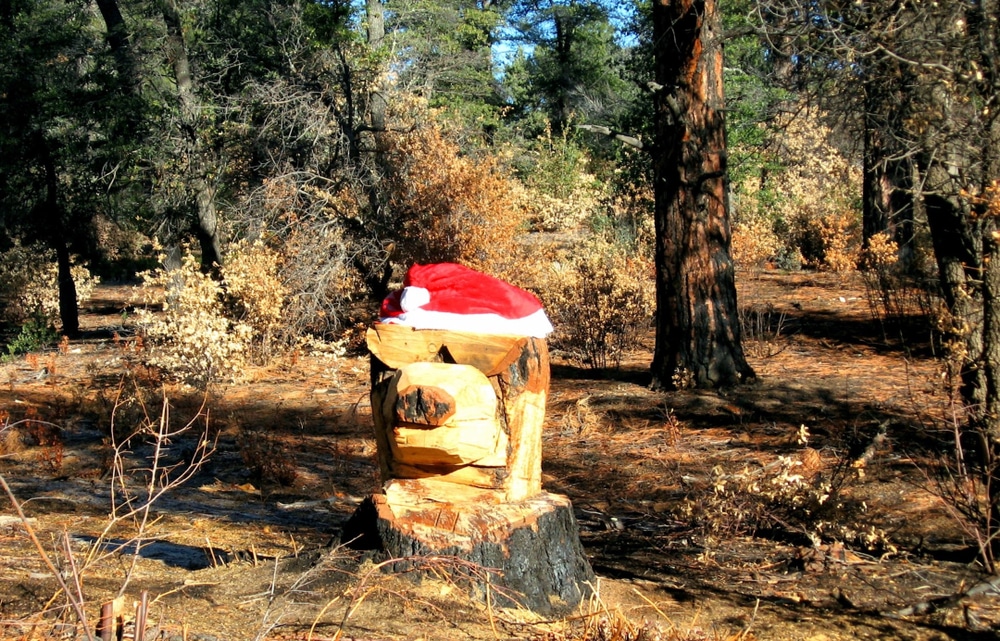Nestled in the rugged terrain of the Mingus Mountains in central Arizona, the ghost town of Cherry stands as a quiet testament to Arizona’s rich mining heritage. Wind whispers through abandoned buildings and rustles the wildflowers that grow among weathered headstones in the small pioneer cemetery. Once a bustling mining community, Cherry now slumbers in the embrace of ponderosa pines and juniper trees, its remaining structures slowly returning to the earth from which the town’s wealth was once extracted. The story of Cherry, its cemeteries, newspapers, and connections to the outside world, offers a window into the hopes, hardships, and legacy of Arizona’s territorial period.

Chloride’s downtown is like an open-air museum of Arizona’s mining past. Wooden storefronts, old signage, weathered homes, and vintage mining equipment tell the story of a boomtown that once boasted saloons, hotels, and a thriving population. Walk the main street, pop into shops, and discover quirky displays around every corner—including a few lovingly maintained historic structures from the 19th century.
A must-see highlight is the Roy Purcell murals, known as the “Painted Rock Murals”, located about a mile east of town along a rough dirt road. Created in 1966 and refreshed in the 2000s, these large, psychedelic rock paintings cover boulders in brilliant colors and symbols. They blend spirituality, mythology, and modern art, and their remote desert setting makes the experience even more striking. The road is rocky—high-clearance vehicles are recommended.
Located in the old Chloride Post Office, the Chloride Historical Society Museum preserves the town’s rich mining heritage. Exhibits include photographs, artifacts, tools, and memorabilia from Chloride’s boom years. It’s a great stop to understand the deeper history behind the buildings and ruins scattered throughout the area.

On the first and third Saturdays of each month, the High Desert Drifters, a local group of Old West reenactors, stage free gunfight shows in Chloride’s center. These fun and theatrical performances bring a little Wild West flair to the town and are often paired with local events or vendors.

The hills surrounding Chloride are dotted with abandoned mine shafts, tailings, and old cabins, many of which are accessible by hiking or 4×4 roads. The terrain offers excellent views of the desert valley and rugged mountains. Always use caution—do not enter mine shafts, and watch for loose rock and wildlife.

With its location at the edge of the Cerbat Mountains, Chloride is a gateway to desert backroads and OHV trails. Off-roaders can explore ghost mines, climb to mountain viewpoints, and connect with other historic sites like Mineral Park or Cerro Colorado. Fall and spring are the best seasons for backcountry drives.
Far from city lights, Chloride offers fantastic stargazing conditions. Visitors who stay overnight in the area, whether camping or lodging, are treated to dark skies filled with stars, planets, and meteor showers during peak seasons.
Behind the weathered headstones in Cherry’s cemetery lie the stories of individuals who lived, worked, loved, and died in this mountain mining community. While specific biographical information for many residents has been lost to time, patterns in the cemetery and regional historical records provide glimpses into their lives.
The graves reflect the demographic reality of early mining camps—predominantly male, with women and children appearing in greater numbers as the community stabilized. Accident victims speak to the dangerous nature of mining work, while family plots with multiple generations suggest those who put down roots and sought to build a future in Cherry.
Among those who would have lived in Cherry were the mine owners and operators, who may have resided in larger homes near the business district or maintained residences in Prescott while overseeing operations from a distance. Professional miners, many bringing skills from earlier mining regions or from European mining traditions, would have formed the backbone of the workforce.
Supporting these mining operations were merchants, saloonkeepers, blacksmiths, teamsters, and others who provided essential services. As families established themselves, teachers, clergy, and other community figures would have appeared. The diversity of roles required to sustain even a small mining town reminds us that Cherry was not merely an industrial site but a community of individuals pursuing their own versions of the American dream.

| Category | Details |
|---|---|
| Name | Chloride, Arizona |
| Type | Living ghost town / historic mining town |
| County | Mohave County |
| Founded | 1860s (mining discovered), town established in 1863 |
| Status | Still inhabited (~250 residents); blends modern life with ghost town ambiance |
| Population (Historic) | ~2,000+ at peak during late 1800s–early 1900s |
| Population (Current) | ~250 (2020 census) |
| Historical Significance | One of the oldest mining towns in Arizona, known for silver, lead, zinc |
| Primary Industries (Historic) | Silver, lead, zinc, and other minerals |
| Post Office | Established in 1873; still in operation |
| Decline Factors | Mine closures, Great Depression, falling metal prices |
| Remnants Today | Ruins, old jail, cabins, railroad depot, and murals in nearby canyon |
| Key Attraction | Roy Purcell’s “Chloride Murals” — large psychedelic rock art panels in the hills |
| Access | Easily accessible from U.S. Highway 93, ~25 miles north of Kingman |
| Geographic Setting | Cerbat Mountains, high desert terrain |
| Elevation | Approx. 4,000 feet (1,219 meters) |
| Climate | High desert – hot summers, cool winters |
| Best For | Ghost town tourists, artists, off-roaders, history buffs, Route 66 travelers |
Cherry emerged in the late 19th century as prospectors discovered rich deposits of gold, silver, and copper in the Mingus Mountain area of Yavapai County. Located approximately 15 miles southwest of Jerome and about 10 miles northeast of Prescott, Cherry was positioned in a mineral-rich region that attracted miners, entrepreneurs, and families seeking opportunity in the Arizona Territory.
While not as famous as nearby mining towns like Jerome, Cherry developed into a modest but viable community centered around several productive mines. The town was likely named for the wild cherries that grew in the vicinity, providing a touch of natural beauty in an otherwise industrious landscape focused on mineral extraction.
The exact foundation date of Cherry isn’t well-documented, but mining activity in the area intensified in the 1880s as prospectors expanded their search beyond the already established claims in Jerome and other nearby locations. As mines were established and began producing, Cherry grew organically from a small mining camp into a more structured community with essential services and amenities.
Today, Cherry exists in a state of dignified decay. Unlike some completely vanished ghost towns, Cherry still offers visible remnants of its mining past. A handful of wooden structures remain standing, though weathered by over a century of exposure to the elements. The old general store, several miners’ cabins, and the remnants of mining operations can still be discerned among the vegetation that has reclaimed much of the site.
Mining equipment, tailings piles, and the occasional rusting piece of machinery provide evidence of the industry that once sustained the community. The mines themselves, now long abandoned, present dangerous openings that have mostly been sealed or fenced off for public safety.
Cherry’s remote location in the Mingus Mountains has protected it from extensive vandalism and souvenir hunting that has impacted more accessible ghost towns. However, this remoteness also means visitors should come prepared with appropriate vehicles and supplies. The site is accessible via forest roads that may require high-clearance vehicles, especially after rain or snow.
One of Cherry’s most poignant features is its small documented pioneer cemetery, mentioned in historical records as existing in the Mingus Mountain area. Situated on a gentle slope overlooking what was once the heart of the community, the cemetery contains graves dating from Cherry’s operational period.
The cemetery is modest in size, reflecting the scale of the community it served. Simple markers, many made of local stone or wood, identify the final resting places of miners, their families, and other residents who made Cherry their home. Some stones bear only initials or have become illegible with time, while others still clearly show names, dates, and occasionally brief epitaphs.
The graves tell stories of the harsh realities of frontier mining life—accident victims, casualties of disease outbreaks, and the particularly heartbreaking frequency of infant and child burials that characterized the era before modern medicine. The cemetery’s layout follows the practical patterns of the time, with family groupings and some evidence of separate areas based on religious affiliation or social standing.
Today, the pioneer cemetery exists in a semi-wild state, with native plants growing among the graves and occasional efforts at maintenance by historical preservation groups or descendants of those buried there. The cemetery provides both a tangible link to Cherry’s human past and a stark reminder of the brevity of the town’s existence.
While specific information about a separate community cemetery distinct from the pioneer burial ground is limited in historical records for Cherry, the documented pioneer cemetery likely evolved to serve broader community needs as Cherry developed from a mining camp into a more established settlement.
As was common in mining communities, burial practices evolved with the town. What might have begun as hastily established gravesites for the earliest residents would have developed more formal organization as the community stabilized. Family plots would have become more common, reflecting the transition from a population of mostly single male miners to one that included families and longer-term residents.
The cemetery would have reflected Cherry’s diverse community, potentially including sections for different ethnic or religious groups that made up the mining workforce. During Cherry’s operational years, these distinctions would have been more apparent, though time has erased many of these boundaries as maintenance declined after the town’s abandonment.
While specific newspapers unique to Cherry aren’t prominently documented in historical records, the community would have been served by publications from nearby larger towns such as Prescott, which hosted several newspapers during the territorial period. These regional papers would have carried news of Cherry’s mining developments, significant events, and occasionally social happenings.
Mining communities of Cherry’s size sometimes supported their own modest publications, often weekly papers that combined local news with reprinted content from larger cities. If Cherry had its own newspaper, it would have operated from a small office in the business district, possibly sharing space with another enterprise to economize on the substantial investment required for printing equipment.
The newspaper would have been vital in connecting Cherry’s residents with each other and the outside world, announcing new strikes, reporting on ore quality, covering accidents and other local events, and publishing essential information about supply deliveries, mail service, and transportation schedules. The paper would have also served as a forum for community debate, particularly regarding mining regulations, water rights, and other issues critical to the town’s prosperity.
Whether Cherry had its own dedicated newspaper or relied on regional publications, the importance of print media in maintaining community identity and connection to the broader world cannot be overstated. The eventual cessation of newspaper coverage would have been both a symptom and a catalyst of the town’s decline.
Cherry’s development was influenced by the regional transportation networks that connected it to larger economic centers. While likely lacking direct rail access given its mountainous location, Cherry would have been served by wagon roads connecting to the nearest rail lines, which expanded throughout Arizona Territory in the late 19th century.
The Atlantic & Pacific Railroad (later part of the Atchison, Topeka & Santa Fe) established a transcontinental route across northern Arizona in the 1880s, while the Prescott & Arizona Central and later the Santa Fe, Prescott & Phoenix Railway connected Prescott to this main line, creating vital transportation links for communities in the Mingus Mountain region.
For Cherry, these rail connections, though not immediate, would have been essential for shipping ore to processing facilities and bringing in the heavy equipment needed for mining operations. Wagon roads, maintained with varying degrees of quality depending on their economic importance, would have connected Cherry to these rail lines, likely with regular stage or freight service.
Transportation challenges would have shaped daily life in Cherry—mail delivery schedules, the availability of supplies, the cost of shipping ore, and the practical difficulty of travel all influencing the community’s development and ultimately contributing to its decline when economic conditions changed.
Like many mining communities in Arizona, Cherry’s fate was tied to the profitability of its mines. As ore quality diminished or mineral prices fluctuated, the economic foundation of the town would have become increasingly precarious. The precise timeline of Cherry’s decline isn’t well-documented, but it likely followed the pattern common to mining towns—a gradual contraction as marginal operations closed, followed by an accelerating exodus once the primary mines ceased production.
The early 20th century brought changes that challenged many small mining operations throughout Arizona. Larger, more industrialized mining operations with better transportation connections could produce minerals more efficiently, while changing national economic conditions altered the profitability of many smaller mines. Environmental factors, including water availability and quality in this mountainous region, may have presented additional challenges.
As mining activity declined, Cherry’s population would have dwindled. Businesses closed, buildings were abandoned or dismantled for materials, and community institutions faded. Some residents might have moved to more promising mining areas or to growing urban centers, while others may have remained in the region as ranchers or in other occupations.
The cemetery would have received fewer new burials as the population declined, though occasional interments might have continued for some time, particularly for former residents who maintained connections to the place. As the years passed, the town transitioned from struggling community to abandoned site, and eventually to the ghost town that remains today.
Cherry represents an important chapter in Arizona’s mining heritage, offering insights into the development and decline of the smaller mining communities that once dotted the state’s mountainous regions. While not as famous as boom towns like Tombstone or Jerome, communities like Cherry collectively employed thousands and produced significant mineral wealth that contributed to Arizona’s development.
The site provides archaeologists and historians with opportunities to study mining techniques, community formation, and daily life in a typical small mining town of the late 19th and early 20th centuries. Material remains—from mining equipment to household artifacts—offer tangible connections to the people who once called Cherry home.
For descendants of Cherry’s residents, the site and particularly its cemetery provide important connections to family history and Arizona’s pioneer past. These connections sometimes inspire preservation efforts aimed at documenting what remains before it is lost to further deterioration.
Cherry’s pioneer cemetery, like many in ghost towns across Arizona, faces ongoing challenges of weathering, erosion, vegetation encroachment, and occasionally vandalism. The cemetery’s remote location offers some protection from human disturbance but also makes regular maintenance difficult.
Preservation efforts have typically been led by historical societies, descendant groups, or volunteers interested in protecting Arizona’s pioneer heritage. These efforts often focus on documentation—recording grave inscriptions, creating maps of burial locations, and researching the individuals interred there—rather than extensive physical restoration, which can be costly and logistically challenging.
Occasionally, descendants or historical groups may conduct cleanup events, removing invasive vegetation, repairing damaged markers, or installing modest fencing to protect the site. These activities help preserve the cemetery as both a historical resource and a place of memorial for those buried there.
The continued existence of Cherry’s cemetery, despite the town’s abandonment and the passage of more than a century, speaks to the cultural importance of burial grounds as anchors of memory and community identity. Even after all other aspects of community life have ceased, the cemetery remains as a permanent marker of human presence and a tangible link to those who came before.
Visitors to Cherry and its cemetery should approach the site with respect for both its historical significance and its status as a final resting place for pioneers. The remote location requires preparation—appropriate vehicles, sufficient water, navigation tools, and awareness of weather conditions are all essential for a safe visit.
Ethical visitation practices include:
For those interested in a more informed experience, connecting with local historical societies or museums before visiting can provide valuable context and guidance. These organizations may occasionally offer guided tours that provide enhanced interpretation of the site’s features and history.
As the sun sets behind the Mingus Mountains, casting long shadows across Cherry’s weathered remains and quiet cemetery, visitors can’t help but reflect on the impermanence of human endeavors and the enduring power of the landscape. The town that once echoed with the sounds of mining machinery, bustling commerce, and community life has returned largely to silence, with only wind and wildlife as regular visitors.
Yet Cherry’s legacy lives on—in the mineral wealth that contributed to Arizona’s development, in the descendants of those who lived and worked there, in the historical record of America’s mining frontier, and in the physical remains that still dot the mountainside. The pioneer cemetery, with its simple markers and untold stories, stands as perhaps the most poignant reminder of the individual lives that collectively created this community.
In Cherry, as in so many ghost towns across the American West, we find a microcosm of larger historical patterns—the quest for resource wealth, the building and abandonment of communities, the harsh realities of frontier life, and ultimately the resilience of those who ventured into uncertain territory seeking opportunity and advancement. Their stories, partially told through what remains and what has been recorded, enrich our understanding of Arizona’s complex past and the multifaceted human experience of the American frontier.
Sharlot Hall Museum, Prescott, Arizona
Contains artifacts and records related to Yavapai County mining communities
Yavapai County Historical Society
Maintains archives and occasionally conducts tours of historical sites
Jerome State Historic Park
Offers context for mining in the broader Mingus Mountain region
Arizona Pioneer & Cemetery Research Project
Documents and preserves information about pioneer burial grounds
Arizona Historical Society archives
Contains newspapers, photographs, and documents from the territorial period
U.S. Geological Survey historical topographic maps
Show the development and decline of mining communities
Arizona State Library, Archives and Public Records
Holds official records related to mining claims and community development
University of Arizona Mining and Geological Engineering department publications
Technical information on historical mining practices
